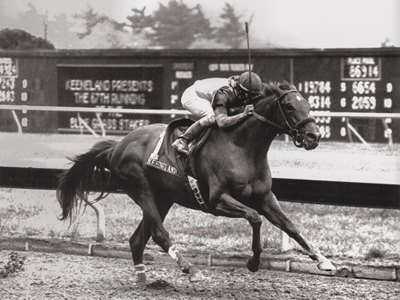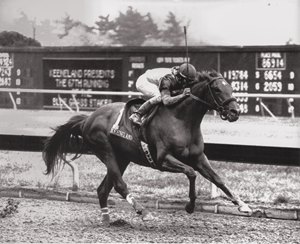Strike the Gold's Blue Grass Close to Zito's Heart


With Keeneland's decision to cancel the spring meet came the realization that the Toyota Blue Grass Stakes (G2) would no longer be part of the 2020 Road to the Kentucky Derby.
Since its inception in 1911, the race has been an important qualifying prep for the first Saturday in May. But for the past 29 years, the Blue Grass has experienced a Derby drought. In almost three decades, no winner of the 1 1/8-mile dirt test has gone on to win the first leg of the Triple Crown.
With COVID-19 forcing Churchill Downs to postpone the Kentucky Derby Presented by Woodford Reserve (G1) to Sept. 5, it is unlikely that the Blue Grass will have a space on this year's calendar. So for one more year, the record will stand. The last horse to grace the winner's circle in both Lexington and Louisville was Strike the Gold in 1991. The son of Alydar took both races for a young Nick Zito, who went on to carve his own name into the annals of history.
"Strike the Gold, he was kind of my first really big horse," the Hall of Fame trainer said. "I had a groom for him, but I was like his groom as well. I would give him a bath every day, do him up, and walk him. We had a bond together, and I still have a million scars from where he bit me all over the place. We used to call him 'Strikey.' I had an incredible relationship with him. He was just a very special horse."

Bred in Kentucky by Calumet Farm out of the Hatchet Man mare Majestic Gold and campaigned for most of his career by B C C Gold Stable or C C W Gold Stable, Strike the Gold did not break his maiden until the end of his 2-year-old year. His first introduction to graded company came the following March, when after hitting the board in two previous allowance attempts, Strike the Gold put in an impressive performance to run second behind Fly So Free in the Florida Derby (G1) at Gulfstream Park.
"We were in Florida, and I had walked back to the barn and I was talking to Neil Howard," Zito said. "Fly So Free had won the Florida Derby, and Neil Howard said, 'Your horse ran good.' But I told Neil, 'I know we can beat Fly So Free.' There was another trainer at the time, a 'B'-type trainer, that said to me, 'Wait until you get him in a race for non-winners of one (conditions),' and I said, 'Non-winners of one? No, I'm going to run him in the Blue Grass.'"
A native New Yorker, Zito made his first trip to Kentucky and to Keeneland as a teenager while working for trainer Woods Garth. He did not make it back to the Lexington oval until more than 20 years later, when he entered Strike the Gold in the marquee race of the spring meet.
"Most people would say I'm an adopted Kentuckian, so the most important thing for me was to go to Keeneland," Zito said. "It wasn't to go to New York and run in the Wood Memorial, even though I am a New Yorker.
"The Blue Grass is special. When you look and think about how many horses come out of the Blue Grass to win the Derby and other big races around the country—there are tons of them. Horses that run in the Blue Grass, even the ones who run second and third, they go on to win the Preakness (G1) and the Belmont (G1). It's a historical race in a historical place. To go to the Blue Grass is really, really special."
With Fly So Free also entered in the Blue Grass and Strike the Gold with plenty to prove, Zito said the young upstart took a shine to the Keeneland surface.
"We go to Kentucky, got off the van, and I had another horse with me named Thirty Six Red, who was my first horse that I ever ran in the Derby. It was just the two horses with me and my groom John. But when we got off the van, it snowed at Keeneland. It was like an eerie feeling, but a good feeling.
"Strike the Gold flourished. The exercise girl, Mary, did a great job and the groom did a great job, but the horse couldn't have done any better. Every single day I would walk him to the track, the weather there in the springtime can be funny, but there is nothing like it."
When Blue Grass Day dawned, jockey Chris Antley had the call. Leaving the gate from the rail, the pair broke slowly but worked quickly to make up ground. Five lengths off the leader as the half-mile went in :47.63, Strike the Gold pressed his rivals coming off the far turn before getting up to take command at the top of the stretch. Antley and Strike the Gold made quick work of the field and crossed the wire three lengths clear.
Fly So Free, who ran just off the pace in second throughout the race, took place honors.
"The track was a little on the wet side, nothing major, and Strike the Gold just went around Fly So Free so fast," Zito said. "It was one of the most memorable Bluegrass Stakes."
Zito kept Strike the Gold at Keeneland as long as he could before shipping to Churchill Downs for the Kentucky Derby. Less than a month after his Bluegrass victory, he gave Zito his first win in the American classic.
"I don't know why or how God blessed me with such a great horse and one that would be the last horse, so far, to win both the Bluegrass and the Kentucky Derby," Zito said. "When you walk around as a young person and tell people you want to win the Kentucky Derby, everyone thinks you're crazy. But it was such a special time. I was so proud and so happy with my horse."

Retired in 1993 with a 6-8-5 record from 31 starts and $3,457,026 in earnings, Strike the Gold remains Zito's most successful earner. He entered stud in 1994 at The Jockey Club of Turkey, where he stood until his death in 2011.
Zito won the Blue Grass twice more, with Halory Hunter in 1998 and The Cliff's Edge in 2004. The trainer's only other Derby winner, 1994 victor Go For Gin, prepped for his Derby bid with a runner-up finish in the Wood Memorial Stakes (G1).
Though a year without the Blue Grass is not ideal for Zito, the Hall of Fame trainer continues to count his blessings. With a string of 20 horses at Oaklawn Park, one of the only tracks in North America still operating in the midst of COVID-19 shutdowns, he's hopeful that racing will resume its normal programming sooner rather than later. Although it's been a few years since he entered a horse in Keeneland's spring headliner, Zito hasn't counted out a return trip.
"Let's say we're at the top of the stretch, so I have a quarter-mile left," Zito joked. "Let's hope I can come out with one more big one before we're done. But the way the world is now, it's good to think about good memories.
"I love the Blue Grass. After Strike the Gold won, I made a remark calling it part of the Kentucky Triple Crown. I had told a reporter I would win the Blue Grass, the Kentucky Derby, and that year the Breeders' Cup Classic (G1) was at Churchill Downs. Had he won that, I would have had the triple. So maybe one year when the Breeders' Cup is back in Kentucky, if someone wins all three, they can earn a special trophy. That could be really fun."
